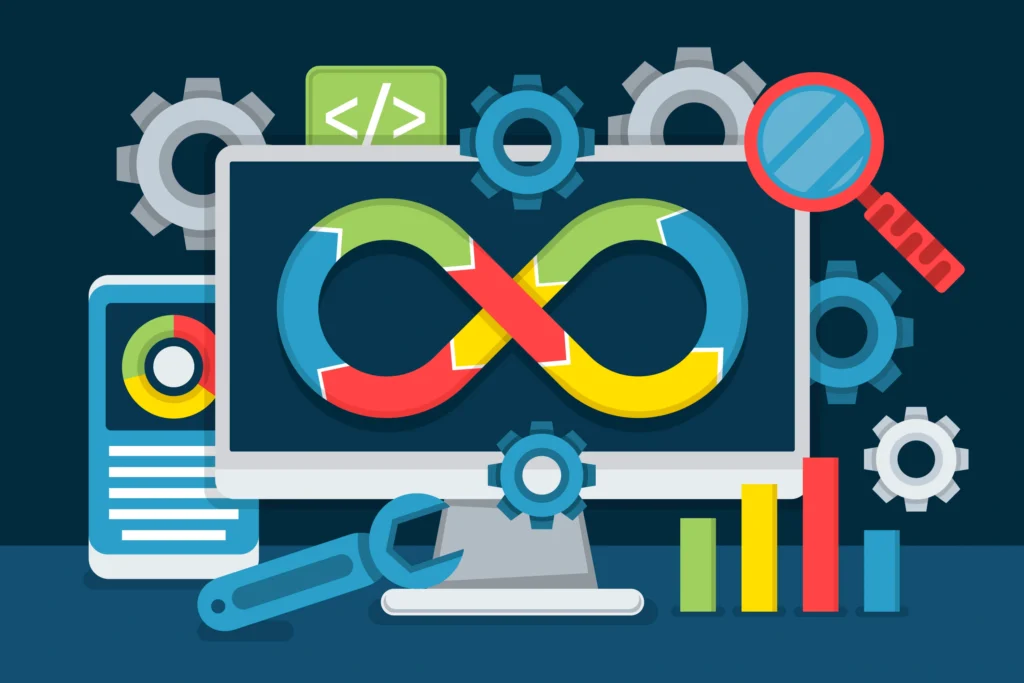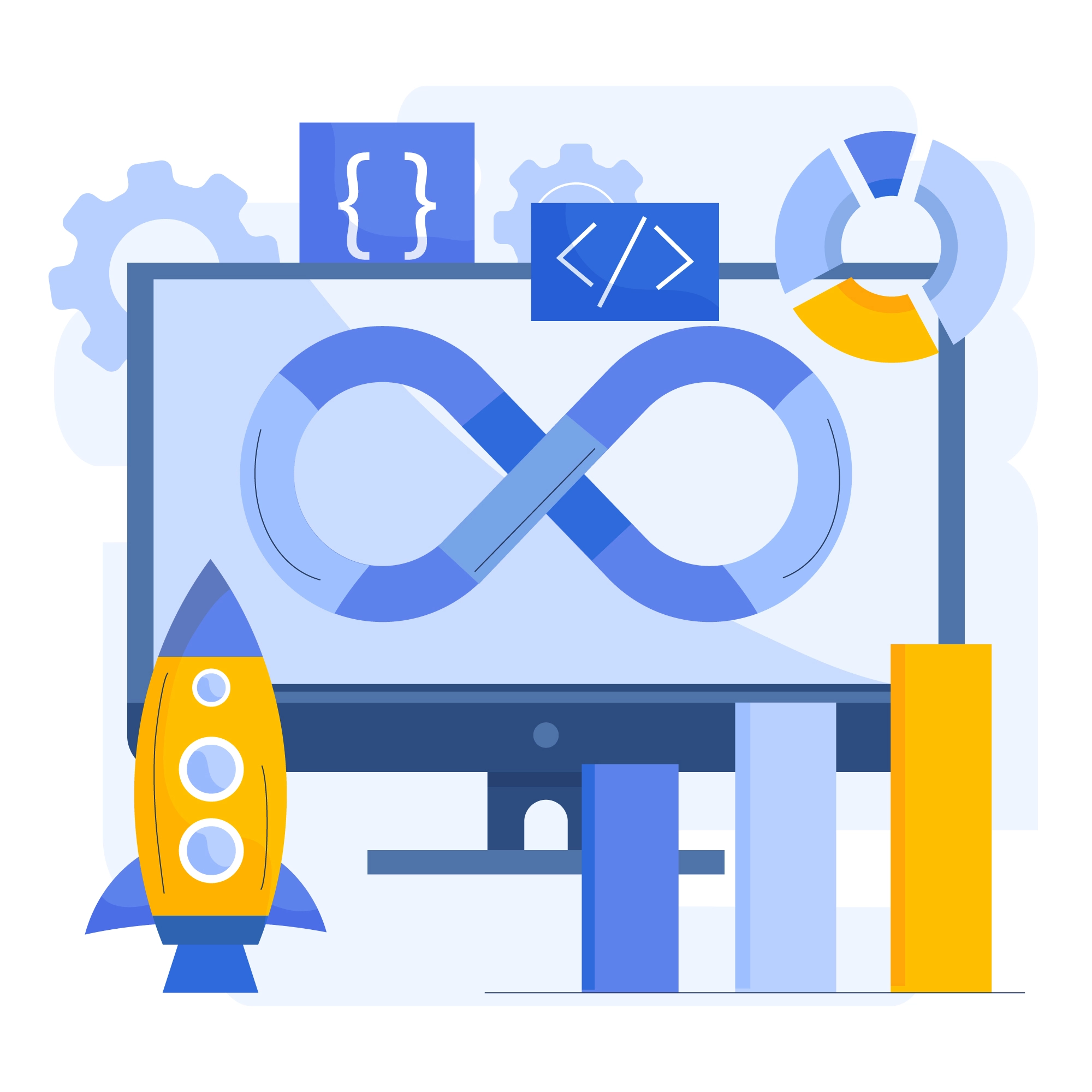Introduction to DevOps
In the digital era, businesses compete not only on the quality of their products but also on how fast they can deliver new features and improvements. Software is at the heart of this race, and delivering it quickly, securely, and reliably has become a top priority.
That’s where DevOps enters the picture.
So, what is DevOps? At its core, DevOps is a cultural philosophy combined with tools and practices that bring software development (Dev) and IT operations (Ops) together. Instead of working in isolated silos, both teams collaborate seamlessly, focusing on automation, efficiency, and continuous improvement throughout the software development lifecycle (SDLC).
By adopting DevOps, organizations gain the ability to release software faster, maintain higher quality, and respond quickly to customer needs.
Why DevOps Matters in Modern Business

The Traditional Problem: Development vs Operations
Historically, developers focused on writing code and shipping new features, while operations teams prioritized stability, uptime, and risk reduction. These two goals often clashed:
- Developers wanted speed → pushing frequent updates.
- Operations wanted stability → resisting rapid changes.
This tension slowed down software delivery and created bottlenecks.
The DevOps Solution
DevOps eliminates this conflict by creating a shared responsibility. Developers and operations teams work together with shared metrics and goals, backed by automation and monitoring tools. This alignment allows businesses to:
- Innovate faster without sacrificing quality
- Reduce downtime and improve customer experience
- Stay competitive in a world where speed matters as much as quality
Key Benefits of DevOps
1. Faster Delivery
CI/CD pipelines ensure that code is tested and deployed automatically, reducing release times from weeks to hours.
2. Improved Collaboration
Cross-functional teams share responsibilities, eliminating blame games between developers and IT staff.
3. Better Quality and Reliability
Automated testing, monitoring, and feedback loops ensure fewer bugs and faster issue resolution.
4. Enhanced Scalability
Containerization and orchestration tools (like Docker and Kubernetes) enable businesses to scale applications effortlessly.
5. Reduced Costs
Automation reduces manual labor and operational inefficiencies, lowering long-term IT costs.
Pros and Cons of DevOps
Pros:
- Faster software releases
- Stronger teamwork and transparency
- Quick recovery from failures
- Higher innovation potential
Cons:
- Cultural shift required (resistance from staff)
- Learning curve for new tools and practices
- Potential over-reliance on automation
- Initial setup and training costs
Core Principles of DevOps (Explained Simply)
Adopting DevOps successfully requires understanding its core principles. Think of these principles as the guiding rules that help teams work better together and deliver software more smoothly. Here’s a breakdown in simple terms:
1. Collaboration – Working Together, Not Apart
In traditional companies, developers (who build the software) and operations teams (who run the software) often worked separately. This caused delays, misunderstandings, and even finger-pointing when something went wrong.
DevOps changes this by encouraging open communication and teamwork. Everyone shares the same goals: making sure the software works well for the customer. It’s like a sports team where players from different positions cooperate to win the game instead of playing only for themselves.
2. Automation – Letting Computers Do the Repetitive Work
Imagine having to do the same boring, manual task every single day. That’s what used to happen in software delivery: people manually tested code, set up servers, and deployed updates.
DevOps introduces automation. Computers take over repetitive tasks such as testing, deployment, and monitoring. This not only saves time but also reduces human errors. Just like washing machines replaced hand-washing clothes, automation makes work faster and more reliable.
3. Continuous Integration & Continuous Delivery (CI/CD) – Small, Frequent Updates
In the past, companies would release big software updates once or twice a year. This often meant long waiting times, complicated releases, and lots of bugs.
With CI/CD, teams release smaller updates more often—sometimes daily or even hourly. Think of it like updating your smartphone apps: you get new features or bug fixes frequently, instead of waiting months for one giant update. This approach keeps the software fresh, stable, and always improving.
4. Infrastructure as Code (IaC) – Managing Computers Like Text Documents
Traditionally, setting up servers or networks required manual work, like a technician configuring each machine by hand. This was slow and inconsistent.
With Infrastructure as Code (IaC), teams use simple code files to describe how servers, networks, and systems should be set up. These files can be stored, shared, and reused—just like documents. This ensures consistency: if one team sets up a system in Europe and another in the U.S., they both get the exact same setup.
5. Monitoring and Feedback – Learning From Data
After software is released, the work isn’t over. Teams need to know: Is it working well? Are customers happy? Is the system fast and stable?
That’s where monitoring comes in. DevOps uses special tools to track how the software behaves in real time. If something breaks, teams get alerts right away. Feedback is also collected from customers and used to improve the product. It’s like having a dashboard in your car—you instantly know if you’re low on fuel or if the engine needs attention.
6. Security Integration (DevSecOps) – Building Safety Into the Process
In the past, security checks often happened at the very end of the development process, which led to delays and vulnerabilities.
With DevSecOps, security is built into every stage of development. Automated tools scan for risks early, and teams fix issues before they become major problems. Think of it like building a house: instead of waiting until the end to add locks and alarms, you design security features into the house from day one.
✅ In summary:
The core principles of DevOps—collaboration, automation, CI/CD, Infrastructure as Code, monitoring, and security—work together to create a faster, safer, and more efficient way of delivering software. Even if you’re not technical, the key idea is simple: DevOps makes teams work more like a well-coordinated orchestra than separate musicians playing alone.
The DevOps Lifecycle Explained
DevOps is not just a set of tools—it’s a lifecycle with interconnected stages:
- Plan – Define project scope, requirements, and roadmap.
- Code – Develop features using version control systems.
- Build – Compile code into deployable artifacts.
- Test – Automated and manual testing for quality assurance.
- Release – Automated deployment into staging/production.
- Deploy – Deliver to production environments.
- Operate – Manage applications and infrastructure.
- Monitor – Collect metrics and logs for continuous feedback.
This cycle is continuous, meaning improvement never stops.
Top DevOps Tools (With Examples)
Version Control & Collaboration
- Git (with GitHub, GitLab, or Bitbucket) – Track code changes, collaborate, and manage pull requests.
CI/CD Tools
- Jenkins – Highly customizable automation server.
- GitLab CI/CD – Built-in pipelines with GitLab repositories.
- CircleCI – Cloud-based CI/CD optimized for performance.
- Azure DevOps – Microsoft’s integrated pipeline solution.
Configuration Management
- Ansible – Agentless automation for IT tasks.
- Chef – Infrastructure as code with strong scripting.
- Puppet – Focuses on managing system configurations at scale.
Containers & Orchestration
- Docker – Creates lightweight containers for apps.
- Kubernetes – Automates scaling, management, and deployment of containers.
- OpenShift – Red Hat’s enterprise Kubernetes platform.
Monitoring & Logging
- Prometheus – Open-source metrics and alerting.
- Grafana – Visualizes monitoring data in real-time.
- ELK Stack (Elasticsearch, Logstash, Kibana) – For logging and data analytics.
- Datadog – Cloud-native monitoring solution.
Security in DevOps (DevSecOps Tools)
- SonarQube – Static code analysis for vulnerabilities.
- Aqua Security – Protects containers and Kubernetes workloads.
- HashiCorp Vault – Secrets management and encryption.
How to Choose the Right DevOps Option
Factors to Consider
- Company Size – Small startups need lightweight tools, enterprises require complex ecosystems.
- Technology Stack – Pick tools that integrate with existing systems.
- Budget – Open-source tools work for many; enterprises may invest in paid solutions.
- Cloud Environment – AWS, Azure, and Google Cloud all have their own DevOps toolkits.
- Skill Level – Adopt tools your team can realistically manage.
Example Roadmaps
- Startup Example – GitHub + CircleCI + Docker.
- Mid-size Company – GitLab + Ansible + Kubernetes.
- Enterprise – Jenkins + Puppet + Kubernetes + Datadog.
DevOps Best Practices
- Automate Testing – Don’t rely on manual QA alone.
- Shift Left Security – Integrate security early in the pipeline.
- Use Infrastructure as Code (IaC) – Manage servers like software.
- Embrace Cloud-Native Tools – Leverage AWS, Azure, or GCP DevOps solutions.
- Measure with Metrics – Key metrics include deployment frequency, lead time, mean time to recovery (MTTR).
- Foster a DevOps Culture – Encourage transparency and shared ownership.
Real-World Examples of DevOps in Action
- Netflix – Uses DevOps pipelines and chaos engineering to deliver content worldwide with high availability.
- Amazon – Deploys code every 11.7 seconds using CI/CD and monitoring systems.
- Etsy – Adopted DevOps to move from slow deployments to multiple releases per day.
These examples show that DevOps is not limited to big tech—any business can benefit.
DevOps vs Agile vs SRE
- Agile – A methodology focused on iterative development.
- DevOps – A cultural and technical practice focused on collaboration and delivery.
- SRE (Site Reliability Engineering) – Focuses on reliability, uptime, and system scalability.
Together, these practices create a holistic approach to software development and operations.
FAQ: What Is DevOps?
What is DevOps in simple words?
DevOps is a way of working that combines development and operations to deliver software faster and more reliably.
Is DevOps just tools?
No. Tools are important, but DevOps is primarily about culture and collaboration.
Do small businesses need DevOps?
Yes. Even startups benefit from automation and faster delivery.
Is DevOps the same as Agile?
No. Agile focuses on how features are built, while DevOps focuses on how they are delivered and maintained.
Which careers exist in DevOps?
DevOps Engineer, Cloud Engineer, Site Reliability Engineer (SRE), and Automation Specialist.
How is DevSecOps different?
DevSecOps integrates security practices into every stage of the DevOps lifecycle.
What are the most used DevOps tools?
Git, Jenkins, Docker, Kubernetes, and Prometheus are among the most widely adopted.
Conclusion
So, what is DevOps? It’s a cultural shift supported by tools, automation, and collaboration that transforms how businesses build and deliver software. By embracing DevOps, organizations achieve faster delivery, better reliability, reduced costs, and happier customers.
Whether you’re a small startup or a global enterprise, adopting DevOps is no longer optional—it’s the foundation of modern software success. Start small, scale gradually, and create a culture where development and operations work as one.

[…] What Is DevOps? Full Guide to Tools, Practices & Benefits Best Python Editor in 2025: Top Tools for Every Developer JavaScript for React: Unlock Seamless Development with These Core Skills Vue js: The Progressive JavaScript Framework for Modern Web Development […]
[…] Coding: The Truth – Is It a Trend or the Future? What Is DevOps? Full Guide to Tools, Practices & Benefits Toxic Work Environment: Signs, Causes, and How to Escape […]